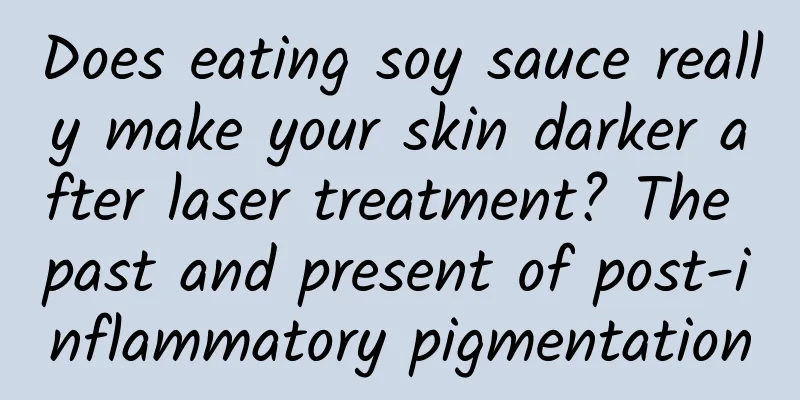Does eating soy sauce really make your skin darker after laser treatment? The past and present of post-inflammatory pigmentation

|
Author: Ge Yiping, deputy chief physician/director of the Laser Department, Dermatology Hospital, Chinese Academy of Medical Sciences Reviewer: Luo Dan, Chief Physician/Doctoral Supervisor, Department of Dermatology, The First Affiliated Hospital of Nanjing Medical University With the rapid development of my country's social economy, more and more people who love beauty are accepting photoelectric beauty treatments, and are even familiar with various technologies such as lasers, intense pulsed light and radio frequency. However, when it comes to deciding whether to accept treatment, they often hesitate because there is a word - "anti-black" lingering in the minds of many beauty seekers. So, let's first talk about what "anti-black" is. Skin darkening For dermatologists, "anti-black" is a colloquialism. The official name is "post-inflammatory pigmentation". As the name suggests, it has two meanings: one is related to inflammation; the other is pigmentation. The so-called "anti-black" is the deposition of skin pigments due to inflammatory reactions, which is manifested as an increase in local pigments, resulting in disfiguring effects. Microscopically, melanocytes that synthesize melanin in the epidermis become hyperfunctional after various inflammatory stimuli and produce a large amount of pigment. When the skin tissue is severely damaged, the epidermal pigment will even fall into the dermis. Therefore, the color of post-inflammatory pigmentation is usually different in depth. The causes of post-inflammatory pigmentation are also varied: acne, commonly known as "pimples", often leaves brown or even black acne marks, the latter is a kind of post-inflammatory pigmentation; pigmentation often occurs locally after skin trauma; after photoelectric treatment, some patients will experience a darkening of the pigment in the treatment area, etc. Although post-inflammatory pigmentation itself is a protective mechanism of the human body, it often brings disfiguring consequences, so the majority of beauty seekers naturally "want to get rid of it as soon as possible". Figure 1 (Copyright image, no reproduction allowed) The origin and composition of skin pigments The color of the skin is composed of different pigment groups, the most important of which are melanin in the epidermis and hemoglobin in the dermal blood vessels, in addition to bilirubin, etc. Under pathological conditions, exogenous pigments (such as tattoo pigments) and iron-containing hemoglobin are also involved in the formation of skin color. Melanin is the most important component in the formation of skin color and is synthesized by melanocytes. The process of melanin synthesis is very complicated. It starts with an amino acid, tyrosine, in the melanosome, and is formed through multiple stages under the catalysis of multiple enzymes composed of more than 100 different proteins. We can imagine the melanosome as a chip factory, and melanin is a high-end chip product. The synthesis of melanin is affected by many factors such as genetics, environment, inflammation, and ultraviolet rays. Will eating soy sauce really make your skin darker after laser treatment? There is a simple view that “you are what you eat”. The raw material for synthesizing melanin is tyrosine. Since soy sauce contains tyrosine, people worry that eating soy sauce after laser treatment will make their skin darker. But is this true? The answer is no. Soy sauce does contain tyrosine, but the content is very small. According to a study, tyrosine only accounts for 3% to 10% of the amino acid composition of soy sauce, and the content of phenylalanine used by the human body to synthesize tyrosine is even less (2% to 5%) [1]. Therefore, the amount of soy sauce used in the daily diet cannot provide a large amount of raw materials for melanin synthesis. Then some people will ask, if soy sauce does not directly provide tyrosine, will it affect melanin synthesis in other ways? There is currently no research evidence to confirm this possibility. Post-inflammatory pigmentation is caused by inflammatory response, so soy sauce is not "blamed". The widely circulated simple food view that "you are what you eat" also needs to be updated. Prevention and treatment of "anti-darkness" after laser treatment Figure 2 Treatment of post-inflammatory pigmentation (copyright image, no reproduction allowed) By achieving three "appropriate" and one "active" aspects, you can effectively prevent and treat post-inflammatory pigmentation that may be caused by laser treatment. Suitable skin condition Laser treatments are not suitable for everyone. For example, people with a recent history of sun exposure, oral photosensitizers, photosensitivity diseases, and damaged skin barriers are not suitable. The risk of pigmentation after surgery is high. Actively treat primary skin diseases and adjust the skin condition before laser treatment to achieve twice the result with half the effort. Appropriate laser treatment strategy and program At present, there are endless treatment projects using energy source equipment such as lasers, and "seeking novelty" and "checking in" have become the trend. But in fact, not all popular projects are suitable for those who seek beauty and patients with disfiguring skin diseases. Dermatologists need to develop treatment strategies based on individual conditions and choose appropriate plans, equipment and parameters to achieve ideal treatment effects. Proper postoperative care Postoperative care for photoelectric therapy is extremely important. The general principle is to promote wound and skin barrier repair, inhibit excessive inflammatory response, and prevent adverse reactions. Good postoperative recovery depends on effective communication between doctors and patients, reasonable use of drugs and products, and adherence to daily life details such as sun protection and moisturizing. Active intervention What should I do if I have post-inflammatory pigmentation? First of all, don't panic. You should know that most post-inflammatory pigmentation will disappear on its own under proper care, usually in a few months. Early and active treatment can use drugs or products containing hydroquinone, arbutin, kojic acid, niacinamide and other ingredients. For post-inflammatory pigmentation that disappears slowly, laser, intense pulsed light or chemical peel can be used as appropriate to promote the disappearance of pigmentation. In general, eating soy sauce will not cause the skin to "re-darken" after laser treatment, but improper treatment and care will. Therefore, laser treatments should be handed over to qualified dermatologists to achieve good results and avoid the trouble of "re-darkening". References [1] Huang Yi, Suo Ran, Li Na. Composition and analysis of amino acids in soy sauce[J]. Chinese Condiments, 2012, 37(3):101-104, 107. |
Recommend
What are the treatments for vulvar leukoplakia?
Women’s private parts, which are their second tre...
What causes urinary pain in little girls
Frequent and painful urination is a very common p...
Is it normal for a pregnant woman to have a big belly?
Pregnancy is one of the most important things in ...
How long after induced abortion can cervical erosion be treated?
Pregnancy is the happiest thing for every married...
Red stringy mucus after medical abortion
It is a normal physiological phenomenon to have r...
What dishes are eaten at the beginning of spring? What traditional vegetables are eaten at the beginning of spring?
The Beginning of Spring is the first of the 24 so...
What to do if your cervix is low
A low cervix generally refers to uterine prolapse...
Can I eat snow peas during menstruation?
Many people like to eat snow peas. There are many...
What causes adnexal cysts?
Women in their childbearing years often develop c...
Faced with the increasing proportion of JN.1 variants, how should we respond this winter and next spring?
With the arrival of winter vacation and Spring Fe...
Menstruation has not come for more than 15 days
If menstruation has not come for more than 15 day...
Blood clots after menstruation
Those few days every month are difficult and inco...
Can I eat cherries while breastfeeding?
Breastfeeding mothers are the focus of care in li...
Can I drink milk during confinement?
Under normal circumstances, drinking milk can not...
Pictures of severe cervical erosion
Patients with cervical erosion have a higher inci...









